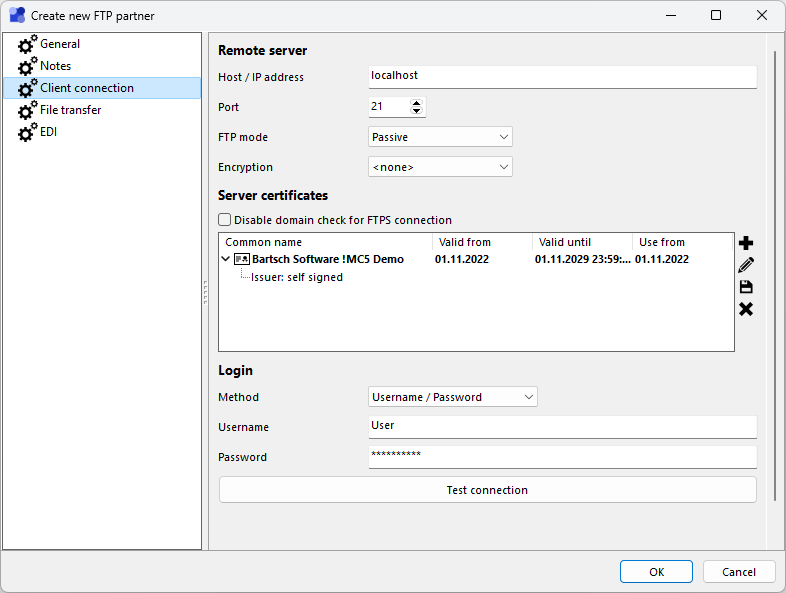
Remote server
Host / IP address
Host name or IP address under which the partner's FTP server can be reached.
Port
Port used by the partner's FTP server. The default port for FTP is port 21.
FTP mode
Mode for establishing additional connections for data transfer. FTP uses multiple connections between client and server for transferring data: One connection for transferring commands (the default port for this is port 21) and one (or more) additional connections for transferring data. The FTP mode determines how the additional connections are established:
•Active - In this mode, the client actively initiates the new connection by opening a port and telling the server to connect to it. For this to work, the server must be able to actively connect to the client, so the client must be reachable "from the outside". This requires appropriate firewall and routing settings.
•Passive (default) - In this mode, the client sends a request to the server to establish a new connection. The server then opens another port and informs the client about it so that it can establish the additional connection there. In this mode, the client does not need to be reachable "from outside".
Encryption
In this selection list you can specify whether the FTP transfer should be encrypted or unencrypted. Encrypted transfer is recommended for transfers in insecure networks, such as the Internet.
The following transfer modes are available:
•<none> - The transfer is unencrypted.
•Explicit TLS - Both the command channel and the data channel are encrypted. This is usually the preferred setting when encryption is to be used.
•ExplicitTLS (only command channel) - Only the command channel is encrypted. This protects the credentials for the FTP connection, such as username and password. However, the data itself is transferred unprotected and may be read or modified by third parties.
Server certificates
Disable domain checking for FTPS connections
For FTP, when the TLS connection to the partner is established, the system checks whether the certificate reported back by the other side contains the domain name that was "dialed" (i.e. the host name specified under Client Connection in the Host / URL field). If the certificate does not match the specified host, then the connection is terminated. Some partners do not specify a host name, but only an IP address for their FTP connections, or they use a certificate that does not contain the host used. In such cases, the domain check must be disabled so that an outgoing connection can be established. In this case, the certificate transmitted by the other party must then correspond exactly to the one that was stored for the partner with the purpose of TLS authentication.
Certificates
If the FTP transfers are to be encrypted, one or more certificates of the partner must be imported in the list of certificates!MC5 automatically uses the latest valid certificate. The currently used certificate is displayed in bold.
Login
Method
Method for logging in to the FTP server. Currently, only Username / Password is available.
Username
Username to be used to log on to the FTP server.
Password
The password to use to log in to the FTP server if Username / Password is selected as the method.
Client key
Client key to be used for logging on to the FTP server.
Test Connection / Get Server Key
Attempts to establish a connection to the FTP server using the data entered under Remote server and Login. This also checks whether data transmission from the server is possible. If no server key or a server key that differs from the received key is specified, then this key is displayed and can be used for the algorithm used by the server.